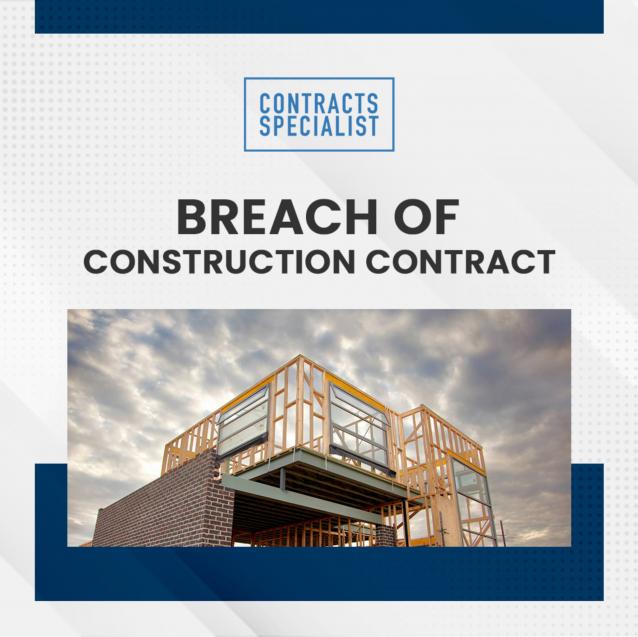
ABIC NSW Contracts: Architect’s Guide
By Contracts Specialist|July 28, 2022
ABIC Contracts are created for members of the Australian Institute of Architects,for projects where the architect is the superintendent of the contract.
These contracts are more detailed than those issued by the Office of the Fair Trading, but still as friendly to homeowners; and, they allow for commercial type of arrangements that you don’t normally find in HIA and MBA contracts.
Types of ABIC Contracts
The most common types of construction contracts issued by the ABIC are:
Major Works and Simple Works may either be for commercial or non-housing projects, or for housing projects.
Major Works - Housing and Simple Works - Housing are used strictly for residential building projects because they contain clauses required by state and territory laws relating to housing.
A Simple Works contract would be best for housing projects because it is brief but still prescriptive enough to cover the main issues. It’s short and basic, but still covers all the bases.
The parties to a Simple Works – Housing contract are:
Section A: Overview
Purpose: Sets out the obligations and warranties of the Architect and the Contractor, and how the Architect, Contractor, and Homeowner will work together.
Includes:
Purpose: Sets out the parties obligations to supply documents, and their recourse should there be discrepancies or conflict.
Includes:
Purpose: Sets out the parties’s securities and release of security.
Includes:
Purpose: Sets out the parties’ liabilities, risks, and indemnities before and after practical completion. One of the most common issues with works is with building defects so the parties are encouraged to take photos and be strict with emailing their findings.
Includes:
Purpose: Sets out the insurance requirements and details about payment of claims.
Includes:
Purpose: Sets out who can access the site and how, as well as the parties’ obligations on site.
Includes:
Purpose: Sets out the Contractor’s and Home Owner’s obligations, subcontracting, and how they will work together
Includes:
Purpose: Sets out the procedure on how a claim to adjust the contract can be made
Includes:
Purpose: Sets out the procedure for claiming variations and managing changes in the works. The parties are encouraged to maintain a variation register and all progress claims identify each of the registered variations.
Includes:
Purpose: Sets out the provisional and prime cost sums, in addition to the contract price, and how they can be adjusted
Includes:
Purpose: Sets out the procedure by which the parties can alter the schedule
Includes:
Purpose: Sets out the practical completion, defects relating to the works, and the liability period after practical completion
Includes:
Purpose: Sets out the obligations of the parties regarding the contract price, progress claims, and final certificate. Progress claims must be assessed pursuant to this clause. The payments must comply with section 8A of the Home Building Act and be made when stages of works are achieved.
Includes:
Purpose: Sets out the process the parties are required to comply with should a dispute arise. The parties must comply with the ABIC Contract dispute resolution procedure including where there are defects and delays with the works.
Includes:
Purpose: Sets out the parties’ rights and obligations concerning termination, and the procedure for effecting a valid termination.
Includes:
Purpose: Sets out additional clauses.
Includes:
Purpose: Lists the legal and/or technical and other terms used in the contract, and how they’re defined in the context of the contract.
How We Can Help
Contracts Specialist can review your ABIC Contract, and dispense the relevant advice, so that you can be able to administer your contract well.
Should you have further question, feel free to reach out to us. Architects get a free first consult.
These contracts are more detailed than those issued by the Office of the Fair Trading, but still as friendly to homeowners; and, they allow for commercial type of arrangements that you don’t normally find in HIA and MBA contracts.
Types of ABIC Contracts
The most common types of construction contracts issued by the ABIC are:
- Major Works
- Simple Works
- Commercial Costs Plus
- Early Works
- Basic Works
Major Works and Simple Works may either be for commercial or non-housing projects, or for housing projects.
Major Works - Housing and Simple Works - Housing are used strictly for residential building projects because they contain clauses required by state and territory laws relating to housing.
A Simple Works contract would be best for housing projects because it is brief but still prescriptive enough to cover the main issues. It’s short and basic, but still covers all the bases.
The parties to a Simple Works – Housing contract are:
- The Architect - administers the contract
- The Contractor - undertakes the work
- The Owner - client who requests the work to be done
Section A: Overview
Purpose: Sets out the obligations and warranties of the Architect and the Contractor, and how the Architect, Contractor, and Homeowner will work together.
Includes:
- Cooperative contracting
- Obligations of the contractor
- Warranties by the contractor
- Obligations of the owner
- Warranties by the owner
- Architect to administer contract
- Architect’s instruction
- Disputing architect’s certificate or written decision
- Disputing architect’s failure to act
- Failure to give certificate, written decision or notice is not acceptance
- Compensation is sole remedy
Purpose: Sets out the parties obligations to supply documents, and their recourse should there be discrepancies or conflict.
Includes:
- Discrepancies or omissions in documents
- Order of precedence of documents
- Contractor and owner must supply copies of official documents
Purpose: Sets out the parties’s securities and release of security.
Includes:
- Security provided to owner
- Security to owner by cash retention
- Security to owner by unconditional guarantees
- Owner’s right to draw on security provided to it
- Procedure for owner to draw on security provided to it
- Owner’s release of security on practical completion
- Owner’s release of security on final certificate
Purpose: Sets out the parties’ liabilities, risks, and indemnities before and after practical completion. One of the most common issues with works is with building defects so the parties are encouraged to take photos and be strict with emailing their findings.
Includes:
- Risk before practical completion
- Indemnity before practical completion
- Risk after practical completion
- Indemnity after practical completion
- Reinstatement during period when contractor bears risk
Purpose: Sets out the insurance requirements and details about payment of claims.
Includes:
- Public liability insurance
- Contract works insurance
- Entitlement to input tax credit
- Insurance cover
- Limited right to arrange insurances
- Contractor and owner not to affect insurance
- Worker’s compensation and employer’s liability insurances
- Insurance claims
- Payment of excess
- Contractor entitled to make progress claim as result of loss or damage
- Warranty insurance
Purpose: Sets out who can access the site and how, as well as the parties’ obligations on site.
Includes:
- Owner to give contractor possession of the site
- Contractors obligations in relation to the site
- Owner warrants that it has given the contractor the site information
- Contractor to examine the site information
- If contractor discovers a latent condition or valuable item
- Architect to instruct in relation to a latent condition or valuable item
- Contractor entitled to claim for latent condition or valuable item
Purpose: Sets out the Contractor’s and Home Owner’s obligations, subcontracting, and how they will work together
Includes:
- Owner’s obligations
- Contractor’s obligations
- Contractor to appoint representative
- Subcontracting
- Contractor to give program to architect
- Contractor to give updated program
- Architect may instruct opening up or testing of the works
- Contractor entitled to claim for costs of opening up or testing
- When contractor entitled to unfixed or demolished materials
Purpose: Sets out the procedure on how a claim to adjust the contract can be made
Includes:
- Time for making a claim to adjust the contract
- Details required for claim
- Architect to assess claim
- Architect to give assessment
- Sum recoverable for claim for adjustment of time costs
- Architect may adjust contract in absence of claim
Purpose: Sets out the procedure for claiming variations and managing changes in the works. The parties are encouraged to maintain a variation register and all progress claims identify each of the registered variations.
Includes:
- Architect may instruct variation to the works
- Contractor to review instruction
- Architect to instruct whether variation is to proceed
- If contractor receives written instruction to proceed
- Adjustment to the contract after written instruction to proceed
- If authorised person issues official document
- Architect to give instruction
- Contractor entitled to make claim for official document
Purpose: Sets out the provisional and prime cost sums, in addition to the contract price, and how they can be adjusted
Includes:
- Provisional and prime cost sums included in contract
- Architect may instruct regarding provisional or prime cost sum
- Architect may instruct contractor to use particular person for provisional or prime cost sum
- Adjustment for provisional or prime cost sum
Purpose: Sets out the procedure by which the parties can alter the schedule
Includes:
- Causes of delay which entitle making a claim for adjustment with costs
- Causes of delay which entitle making claim for adjustment of time without costs
- Contractor to notify of delay
- Contractor to allow for delays
- Adjustment of provisional allowance for delays
- Overlapping delays
Purpose: Sets out the practical completion, defects relating to the works, and the liability period after practical completion
Includes:
- Practical completion
- Inspection by the contractor
- Notification to architect of practical completion
- Architect to decide if the works have reached practical completion
- If the works not at practical completion
- Contractor to bring the works to practical completion
- If architect fails to issue notice of practical completion
- Possession of the works before practical completion
- Liquidated damages may be payable
- Deduction of liquidated damages
- Contractor to correct defects and finalise work
- If the contractor fails to correct defects and finalise work
- Defects liability period
- Contractor’s obligations during and after defects liability period
Purpose: Sets out the obligations of the parties regarding the contract price, progress claims, and final certificate. Progress claims must be assessed pursuant to this clause. The payments must comply with section 8A of the Home Building Act and be made when stages of works are achieved.
Includes:
- Contract price
- Owner’s obligation to pay contract price
- Stage payment claims – procedure for contractor
- Progress claims – procedure for architect
- Tax invoice
- Certificates – obligation to pay
- Before making first progress payment
- If architect fails to issue certificate
- Contractor entitled to make claim
- Final claim – procedure for contractor
- Final certificate – procedure for architect
- Final certificate – tax invoice
- Final certificate – obligation to pay
- Effect of final certificate
- Interest on overdue amounts
- Payment of deposit
- Time for assessing deposit
Purpose: Sets out the process the parties are required to comply with should a dispute arise. The parties must comply with the ABIC Contract dispute resolution procedure including where there are defects and delays with the works.
Includes:
- Each party must continue to perform its obligations
- Compulsory conference
- Mediation
- Legal rights
Purpose: Sets out the parties’ rights and obligations concerning termination, and the procedure for effecting a valid termination.
Includes:
- Owner may require contractor to remedy default
- Owner may immediately terminate
- Owner may take possession of the site
- Assignment of contractor’s rights
- Owner may contract with others to complete the works
- Owner not bound to make any further payment to contractor
- Owner may pay subcontractor or suppliers
- Architect to give assessment of cost of completing the works
- Architect to give certificate of amount payable to contractor or owner
- Contractor or owner to pay under clause Q9
- Contractor may require owner to remedy default
- Contractor may suspend if default not remedied
- Contractor’s subsequent right to terminate
- Contractor may immediately terminate
- Contractor’s entitlement after termination
- Procedure for contractor to make claim
- Architect to give certificate
- Contractor or owner to pau under clause Q17
- If this contract is frustrated
Purpose: Sets out additional clauses.
Includes:
- Transmission of documents
- Time document is received
- Assignment
- Entire contract
- Contract to benefit successors and assignees
- Severability
- Waiver
- Governing law
- Compliance with law
- Change in relevant legislation
- Interpretation of headings
- Contractor and owner to observe confidentiality
- General interpretation
Purpose: Lists the legal and/or technical and other terms used in the contract, and how they’re defined in the context of the contract.
How We Can Help
Contracts Specialist can review your ABIC Contract, and dispense the relevant advice, so that you can be able to administer your contract well.
Should you have further question, feel free to reach out to us. Architects get a free first consult.



